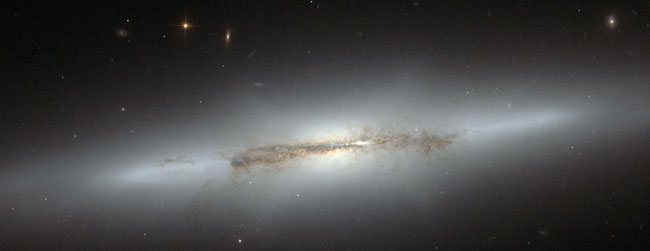Hubble Spies Galaxy's Big Bulge

A new image of the bulge at the center of a distant spiralgalaxy, taken by the Hubble Space Telescope, is giving astronomers insight intohow these galactic paunches form.
The image of NGC 4710 is part of a survey that astronomershave conducted to learn more about the formation of bulges, which are asubstantial component of most spiralgalaxies.
When targeting spiral galaxy bulges, astronomers often seekedge-on galaxies, as their bulges are more easily distinguishable from thedisc. The detailed edge-on view of NGC 4710, taken with Hubble's AdvancedCamera for Surveys, shows the galaxy?s bulge in its brightly colored center.
The luminous, elongated white plane that runs through thebulge is the galaxy disc. The disc and bulge are surrounded by eerie-lookingdust lanes.
When staring directly at the center of the galaxy, one candetect a faint, ethereal ?X?-shaped structure. Such a feature, whichastronomers call a ?boxy? or ?peanut-shaped? bulge, is due to the verticalmotions of the stars in the galaxy?s bar and is only evident when the galaxy isseen edge-on.
This curiously shaped puff is often observed in spiralgalaxies with small bulges and open arms, but is less common in spirals witharms tightly wrapped around a more prominent bulge, such as NGC 4710.
NGC 4710 is a member of the giant Virgo Cluster of galaxiesand lies in the northern constellation of Coma Berenices (the Hair of QueenBerenice). William Herschel discovered the galaxy in the 1780s and noted itsimply as a ?faint nebula."
Get the Space.com Newsletter
Breaking space news, the latest updates on rocket launches, skywatching events and more!
It lies about 60 million light-years from the Earth and isan example of a lenticular or S0-type galaxy ? a type that seems to have somecharacteristics of both spiraland elliptical galaxies.
Astronomers are scrutinizing these systems to determine howmany globular clusters they host. Globular clusters are thought to represent anindication of the processes that can buildbulges.
Two quite different processes are believed to be at playregarding the formation of bulges in spiral galaxies: either they formed ratherrapidly in the early universe, before the spiral disc and arms formed; or theybuilt up from material accumulating from the disc during a slow and longevolution.
In the case of NGC 4710, researchers have spotted very fewglobular clusters associated with the bulge, indicating that its assemblymainly involved relatively slow processes.
- Video - Stunning New Images from Hubble
- Video - Spiral Galaxy Evolution
- Images: Amazing Galaxies
Join our Space Forums to keep talking space on the latest missions, night sky and more! And if you have a news tip, correction or comment, let us know at: community@space.com.

Space.com is the premier source of space exploration, innovation and astronomy news, chronicling (and celebrating) humanity's ongoing expansion across the final frontier. Originally founded in 1999, Space.com is, and always has been, the passion of writers and editors who are space fans and also trained journalists. Our current news team consists of Editor-in-Chief Tariq Malik; Editor Hanneke Weitering, Senior Space Writer Mike Wall; Senior Writer Meghan Bartels; Senior Writer Chelsea Gohd, Senior Writer Tereza Pultarova and Staff Writer Alexander Cox, focusing on e-commerce. Senior Producer Steve Spaleta oversees our space videos, with Diana Whitcroft as our Social Media Editor.









